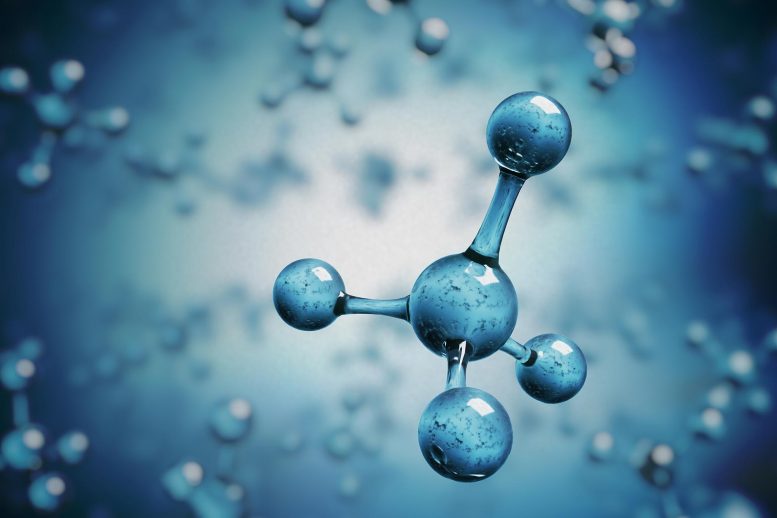
PFAS are a large, complex category of manufactured chemicals that are found in many commonplace products.
A new method beheads PFAS, causing it to break down into benign end products.
The term “forever chemicals” refers to a group of manufactured chemicals that have been used extensively since the 1940s. They cannot be destroyed by fire, eaten by bacteria, or diluted by water. Furthermore, if these harmful chemicals are buried, they seep into the earth surrounding them and persist for future generations.
Chemists at Northwestern University have now accomplished what seemed impossible. The study team created a technique that causes two key classes of PFAS compounds to break down, leaving only benign end products behind. It requires low temperatures and cheap, common reagents.
The simple method may prove to be an effective way to ultimately get rid of these harmful chemicals, which have been connected to several harmful impacts on human, livestock, and environmental health.
The findings were published in the journal Science.
“PFAS has become a major societal problem,” said Northwestern’s William Dichtel, who led the study. “Even just a tiny, tiny amount of PFAS causes negative health effects, and it does not break down. We can’t just wait out this problem. We wanted to use chemistry to address this problem and create a solution that the world can use. It’s exciting because of how simple — yet unrecognized — our solution is.”
Dichtel is the Robert L. Letsinger Professor of Chemistry in Northwestern’s Weinberg College of Arts and Sciences. Brittany Trang, who conducted the project as a part of her recently completed doctoral thesis in Dichtel’s laboratory, is the paper’s co-first author.
‘The same category as lead’
Short for per- and polyfluoroalkyl substances, PFAS has been in use for 70 years as nonstick and waterproofing agents. They are commonly found in nonstick cookware, waterproof cosmetics, firefighting foams, water-repellent fabrics, and products that resist grease and oil.
But over time, PFAS has found its way out of consumer goods and into our water supply and even into the blood of 97% of Americans. Exposure to PFAS is strongly linked to decreased fertility, impacts on children’s development, higher risks for many forms of cancer, reduced immunity to infections, and elevated cholesterol levels, although the health implications are not yet completely understood. The U.S. Environmental Protection Agency (EPA) has deemed numerous PFAS unsafe — even at low levels — in light of these detrimental health effects.
“Recently, the EPA revised its recommendations for PFOA essentially down to zero,” Dichtel said. “That puts several PFAS into the same category as lead.”
Unbreakable bonds
Although community efforts to filter PFAS from water have been successful, there are few solutions for how to dispose of PFAS once it is removed. The few options that are now emerging generally involved PFAS destruction at high temperatures and pressures or other methods that require large energy inputs.
“In New York state, a plant claiming to incinerate PFAS was found to be releasing some of these compounds into the air,” Dichtel said. “The compounds were emitted from the smokestacks and into the local community. Another failed strategy has been to bury the compounds in landfills. When you do that, you are basically just guaranteeing that you will have a problem 30 years from now because it’s going to slowly leach out. You didn’t solve the problem. You just kicked the can down the road.”
The secret to PFAS’s indestructibility lies in its chemical bonds. PFAS contains many carbon-fluorine bonds, which are the strongest bonds in organic chemistry. As the most electronegative element in the periodic table, fluorine wants electrons — and badly. Carbon, on the other hand, is more willing to give up its electrons.
“When you have that kind of difference between two atoms — and they are roughly the same size, which carbon and fluorine are — that’s the recipe for a really strong bond,” Dichtel explained.
Pinpointing PFAS’ Achilles’ heel
But, while studying the compounds, Dichtel’s team found a weakness. PFAS contains a long tail of unyielding carbon-fluorine bonds. But at one end of the molecule, there is a charged group that often contains charged oxygen atoms. Dichtel’s team targeted this head group by heating the PFAS in dimethyl sulfoxide — an unusual solvent for PFAS destruction — with sodium hydroxide, a common reagent. The process decapitated the head group, leaving behind a reactive tail.
“That triggered all these reactions, and it started spitting out fluorine atoms from these compounds to form fluoride, which is the safest form of fluorine,” Dichtel said. “Although carbon-fluorine bonds are super strong, that charged head group is the Achilles’ heel.”
In previous attempts to destroy PFAS, other researchers have used high temperatures — up to 400 degrees Celsius. Dichtel is excited that the new technique relies on milder conditions and a simple, inexpensive reagent, making the solution potentially more practical for widespread use.
After discovering the PFAS degradation conditions, Dichtel and Trang also discovered that the fluorinated pollutants fall apart by different processes than generally assumed. Using powerful computational methods, collaborators Ken Houk at UCLA and Yuli Li, a student at Tianjin University who virtually visited Houk’s group, simulated the PFAS degradation. Their calculations suggest that PFAS falls apart by more complex processes than expected.
Although it was previously assumed that PFAS should fall apart one carbon at a time, the simulation showed that PFAS actually falls apart two or three carbons at a time — a discovery that matched Dichtel and Trang’s experiments. By understanding these pathways, researchers can confirm that only benign products remain. This new knowledge also could help guide further improvements to the method.
“This proved to be a very complex set of calculations that challenged the most modern quantum mechanical methods and fastest computers available to us,” said Houk, a distinguished research professor in organic chemistry. “Quantum mechanics is the mathematical method that simulates all of chemistry, but only in the last decade have we been able to take on large mechanistic problems like this, evaluating all the possibilities and determining which one can happen at the observed rate. Yuli has mastered these computational methods and worked with Brittany long distance to solve this fundamental but practically significant problem.”
Ten down, 11,990 to go
Next, Dichtel’s team will test the effectiveness of its new strategy on other types of PFAS. In the current study, they successfully degraded 10 perfluoroalkyl carboxylic acids (PFCAs) and perfluoroalkyl ether carboxylic acids (PFECAs), including perfluorooctanoic acid (PFOA) and one of its common replacements, known as GenX — two of the most prominent PFAS compounds. The U.S. EPA, however, has identified more than 12,000 PFAS compounds.
Although this might seem daunting, Dichtel remains hopeful.
“Our work addressed one of the largest classes of PFAS, including many we are most concerned about,” he said. “There are other classes that don’t have the same Achilles’ heel, but each one will have its own weakness. If we can identify it, then we know how to activate it to destroy it.”
Reference: “Low-temperature mineralization of perfluorocarboxylic acids” by Brittany Trang, Yuli Li, Xiao-Song Xue, Mohamed Ateia, K. N. Houk and William R. Dichtel, 18 August 2022, Science.
DOI: 10.1126/science.abm8868
Dichtel is a member of the Institute for Sustainability and Energy at Northwestern’s Program on Plastics, Ecosystems, and Public Health; the Center for Water Research and the International Institute for Nanotechnology
The study was funded by the National Science Foundation.









Be the first to comment on "Accomplishing the Impossible: New, Simple Method Can Destroy “Forever” Chemicals"